Jun Hao Liew
The Scalability of Simplicity: Empirical Analysis of Vision-Language Learning with a Single Transformer
Apr 14, 2025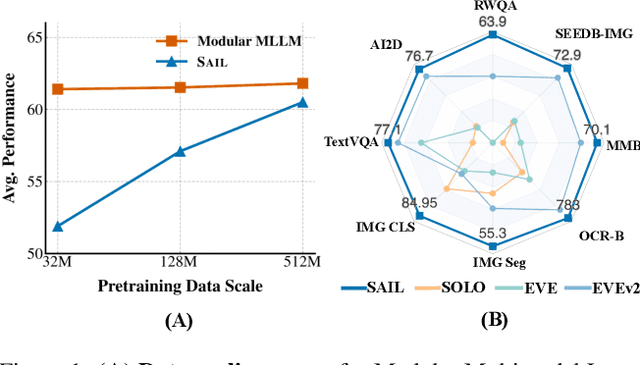
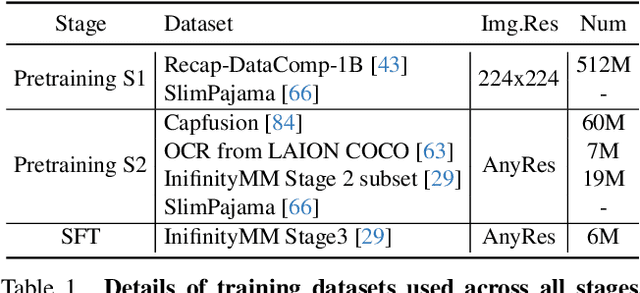
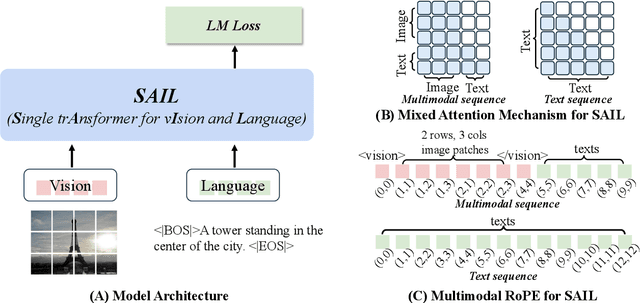
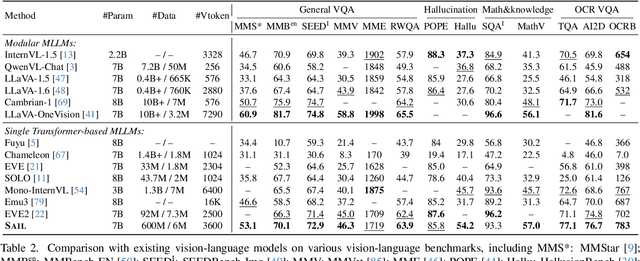
Abstract:This paper introduces SAIL, a single transformer unified multimodal large language model (MLLM) that integrates raw pixel encoding and language decoding within a singular architecture. Unlike existing modular MLLMs, which rely on a pre-trained vision transformer (ViT), SAIL eliminates the need for a separate vision encoder, presenting a more minimalist architecture design. Instead of introducing novel architectural components, SAIL adapts mix-attention mechanisms and multimodal positional encodings to better align with the distinct characteristics of visual and textual modalities. We systematically compare SAIL's properties-including scalability, cross-modal information flow patterns, and visual representation capabilities-with those of modular MLLMs. By scaling both training data and model size, SAIL achieves performance comparable to modular MLLMs. Notably, the removal of pretrained ViT components enhances SAIL's scalability and results in significantly different cross-modal information flow patterns. Moreover, SAIL demonstrates strong visual representation capabilities, achieving results on par with ViT-22B in vision tasks such as semantic segmentation. Code and models are available at https://github.com/bytedance/SAIL.
GigaTok: Scaling Visual Tokenizers to 3 Billion Parameters for Autoregressive Image Generation
Apr 11, 2025Abstract:In autoregressive (AR) image generation, visual tokenizers compress images into compact discrete latent tokens, enabling efficient training of downstream autoregressive models for visual generation via next-token prediction. While scaling visual tokenizers improves image reconstruction quality, it often degrades downstream generation quality -- a challenge not adequately addressed in existing literature. To address this, we introduce GigaTok, the first approach to simultaneously improve image reconstruction, generation, and representation learning when scaling visual tokenizers. We identify the growing complexity of latent space as the key factor behind the reconstruction vs. generation dilemma. To mitigate this, we propose semantic regularization, which aligns tokenizer features with semantically consistent features from a pre-trained visual encoder. This constraint prevents excessive latent space complexity during scaling, yielding consistent improvements in both reconstruction and downstream autoregressive generation. Building on semantic regularization, we explore three key practices for scaling tokenizers:(1) using 1D tokenizers for better scalability, (2) prioritizing decoder scaling when expanding both encoder and decoder, and (3) employing entropy loss to stabilize training for billion-scale tokenizers. By scaling to $\bf{3 \space billion}$ parameters, GigaTok achieves state-of-the-art performance in reconstruction, downstream AR generation, and downstream AR representation quality.
MagicArticulate: Make Your 3D Models Articulation-Ready
Feb 18, 2025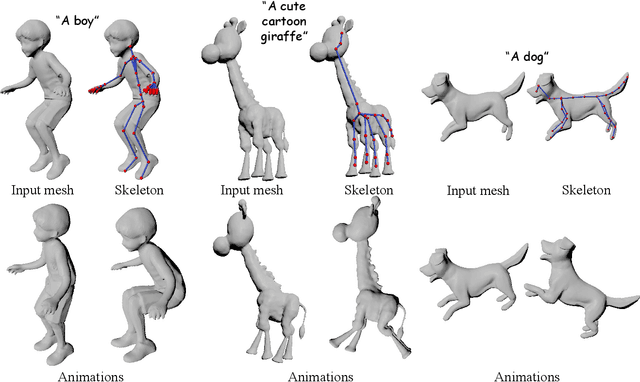
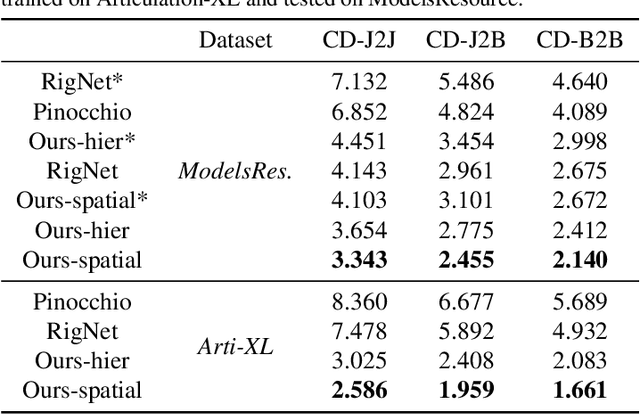
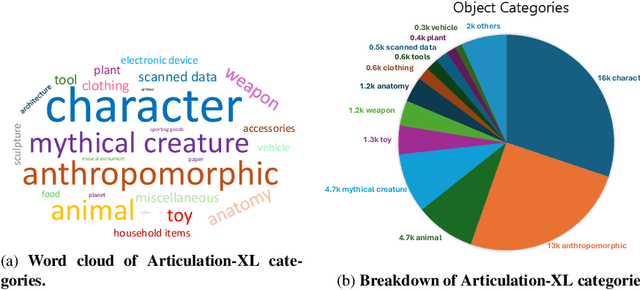
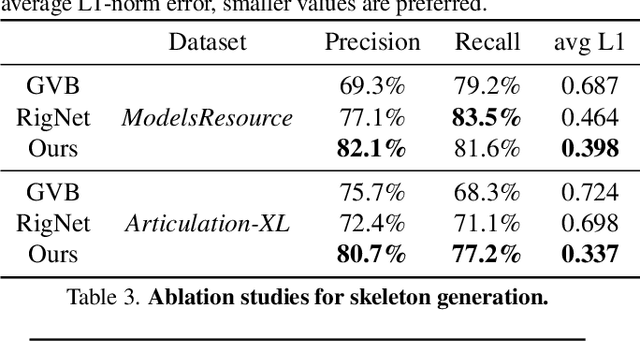
Abstract:With the explosive growth of 3D content creation, there is an increasing demand for automatically converting static 3D models into articulation-ready versions that support realistic animation. Traditional approaches rely heavily on manual annotation, which is both time-consuming and labor-intensive. Moreover, the lack of large-scale benchmarks has hindered the development of learning-based solutions. In this work, we present MagicArticulate, an effective framework that automatically transforms static 3D models into articulation-ready assets. Our key contributions are threefold. First, we introduce Articulation-XL, a large-scale benchmark containing over 33k 3D models with high-quality articulation annotations, carefully curated from Objaverse-XL. Second, we propose a novel skeleton generation method that formulates the task as a sequence modeling problem, leveraging an auto-regressive transformer to naturally handle varying numbers of bones or joints within skeletons and their inherent dependencies across different 3D models. Third, we predict skinning weights using a functional diffusion process that incorporates volumetric geodesic distance priors between vertices and joints. Extensive experiments demonstrate that MagicArticulate significantly outperforms existing methods across diverse object categories, achieving high-quality articulation that enables realistic animation. Project page: https://chaoyuesong.github.io/MagicArticulate.
High Quality Human Image Animation using Regional Supervision and Motion Blur Condition
Sep 29, 2024



Abstract:Recent advances in video diffusion models have enabled realistic and controllable human image animation with temporal coherence. Although generating reasonable results, existing methods often overlook the need for regional supervision in crucial areas such as the face and hands, and neglect the explicit modeling for motion blur, leading to unrealistic low-quality synthesis. To address these limitations, we first leverage regional supervision for detailed regions to enhance face and hand faithfulness. Second, we model the motion blur explicitly to further improve the appearance quality. Third, we explore novel training strategies for high-resolution human animation to improve the overall fidelity. Experimental results demonstrate that our proposed method outperforms state-of-the-art approaches, achieving significant improvements upon the strongest baseline by more than 21.0% and 57.4% in terms of reconstruction precision (L1) and perceptual quality (FVD) on HumanDance dataset. Code and model will be made available.
Empowering Visual Creativity: A Vision-Language Assistant to Image Editing Recommendations
May 31, 2024

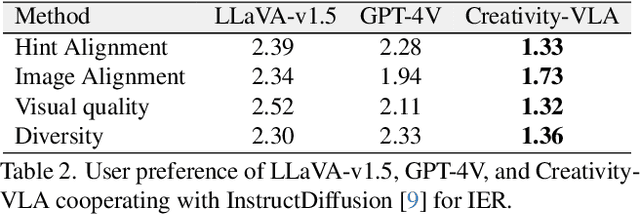
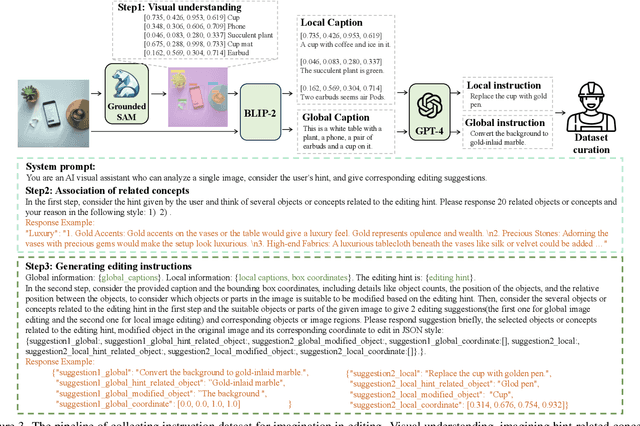
Abstract:Advances in text-based image generation and editing have revolutionized content creation, enabling users to create impressive content from imaginative text prompts. However, existing methods are not designed to work well with the oversimplified prompts that are often encountered in typical scenarios when users start their editing with only vague or abstract purposes in mind. Those scenarios demand elaborate ideation efforts from the users to bridge the gap between such vague starting points and the detailed creative ideas needed to depict the desired results. In this paper, we introduce the task of Image Editing Recommendation (IER). This task aims to automatically generate diverse creative editing instructions from an input image and a simple prompt representing the users' under-specified editing purpose. To this end, we introduce Creativity-Vision Language Assistant~(Creativity-VLA), a multimodal framework designed specifically for edit-instruction generation. We train Creativity-VLA on our edit-instruction dataset specifically curated for IER. We further enhance our model with a novel 'token-for-localization' mechanism, enabling it to support both global and local editing operations. Our experimental results demonstrate the effectiveness of \ours{} in suggesting instructions that not only contain engaging creative elements but also maintain high relevance to both the input image and the user's initial hint.
DiG: Scalable and Efficient Diffusion Models with Gated Linear Attention
May 28, 2024



Abstract:Diffusion models with large-scale pre-training have achieved significant success in the field of visual content generation, particularly exemplified by Diffusion Transformers (DiT). However, DiT models have faced challenges with scalability and quadratic complexity efficiency. In this paper, we aim to leverage the long sequence modeling capability of Gated Linear Attention (GLA) Transformers, expanding its applicability to diffusion models. We introduce Diffusion Gated Linear Attention Transformers (DiG), a simple, adoptable solution with minimal parameter overhead, following the DiT design, but offering superior efficiency and effectiveness. In addition to better performance than DiT, DiG-S/2 exhibits $2.5\times$ higher training speed than DiT-S/2 and saves $75.7\%$ GPU memory at a resolution of $1792 \times 1792$. Moreover, we analyze the scalability of DiG across a variety of computational complexity. DiG models, with increased depth/width or augmentation of input tokens, consistently exhibit decreasing FID. We further compare DiG with other subquadratic-time diffusion models. With the same model size, DiG-XL/2 is $4.2\times$ faster than the recent Mamba-based diffusion model at a $1024$ resolution, and is $1.8\times$ faster than DiT with CUDA-optimized FlashAttention-2 under the $2048$ resolution. All these results demonstrate its superior efficiency among the latest diffusion models. Code is released at https://github.com/hustvl/DiG.
ClassDiffusion: More Aligned Personalization Tuning with Explicit Class Guidance
May 27, 2024Abstract:Recent text-to-image customization works have been proven successful in generating images of given concepts by fine-tuning the diffusion models on a few examples. However, these methods tend to overfit the concepts, resulting in failure to create the concept under multiple conditions (e.g. headphone is missing when generating a <sks> dog wearing a headphone'). Interestingly, we notice that the base model before fine-tuning exhibits the capability to compose the base concept with other elements (e.g. a dog wearing a headphone) implying that the compositional ability only disappears after personalization tuning. Inspired by this observation, we present ClassDiffusion, a simple technique that leverages a semantic preservation loss to explicitly regulate the concept space when learning the new concept. Despite its simplicity, this helps avoid semantic drift when fine-tuning on the target concepts. Extensive qualitative and quantitative experiments demonstrate that the use of semantic preservation loss effectively improves the compositional abilities of the fine-tune models. In response to the ineffective evaluation of CLIP-T metrics, we introduce BLIP2-T metric, a more equitable and effective evaluation metric for this particular domain. We also provide in-depth empirical study and theoretical analysis to better understand the role of the proposed loss. Lastly, we also extend our ClassDiffusion to personalized video generation, demonstrating its flexibility.
InstaDrag: Lightning Fast and Accurate Drag-based Image Editing Emerging from Videos
May 22, 2024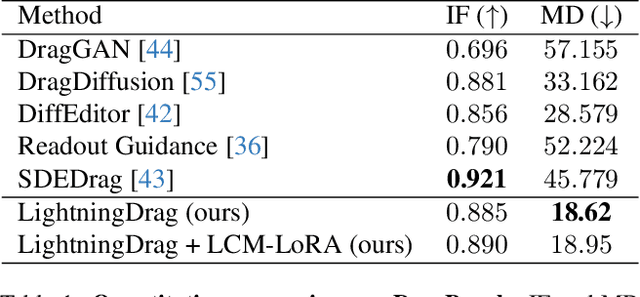

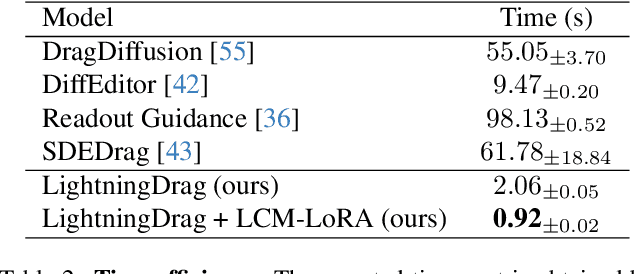
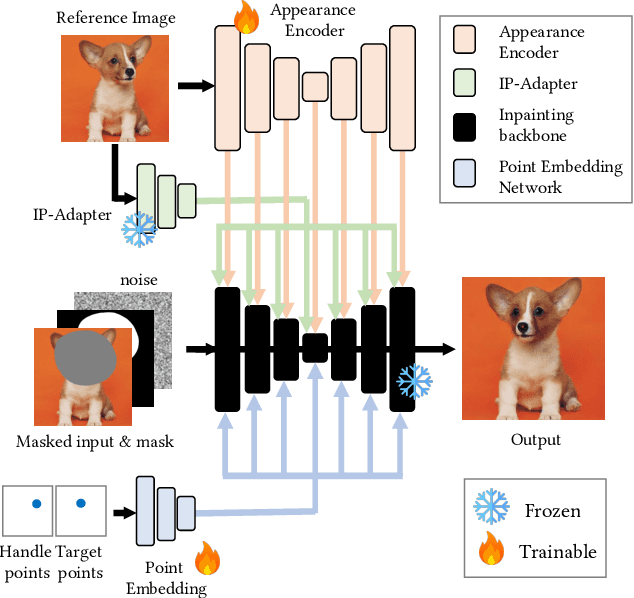
Abstract:Accuracy and speed are critical in image editing tasks. Pan et al. introduced a drag-based image editing framework that achieves pixel-level control using Generative Adversarial Networks (GANs). A flurry of subsequent studies enhanced this framework's generality by leveraging large-scale diffusion models. However, these methods often suffer from inordinately long processing times (exceeding 1 minute per edit) and low success rates. Addressing these issues head on, we present InstaDrag, a rapid approach enabling high quality drag-based image editing in ~1 second. Unlike most previous methods, we redefine drag-based editing as a conditional generation task, eliminating the need for time-consuming latent optimization or gradient-based guidance during inference. In addition, the design of our pipeline allows us to train our model on large-scale paired video frames, which contain rich motion information such as object translations, changing poses and orientations, zooming in and out, etc. By learning from videos, our approach can significantly outperform previous methods in terms of accuracy and consistency. Despite being trained solely on videos, our model generalizes well to perform local shape deformations not presented in the training data (e.g., lengthening of hair, twisting rainbows, etc.). Extensive qualitative and quantitative evaluations on benchmark datasets corroborate the superiority of our approach. The code and model will be released at https://github.com/magic-research/InstaDrag.
PeRFlow: Piecewise Rectified Flow as Universal Plug-and-Play Accelerator
May 13, 2024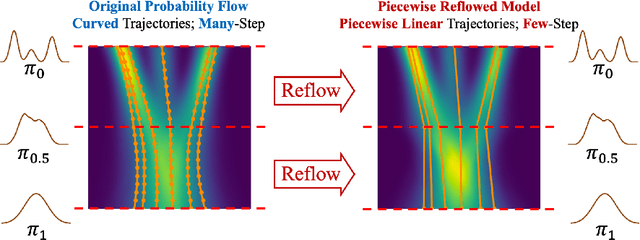

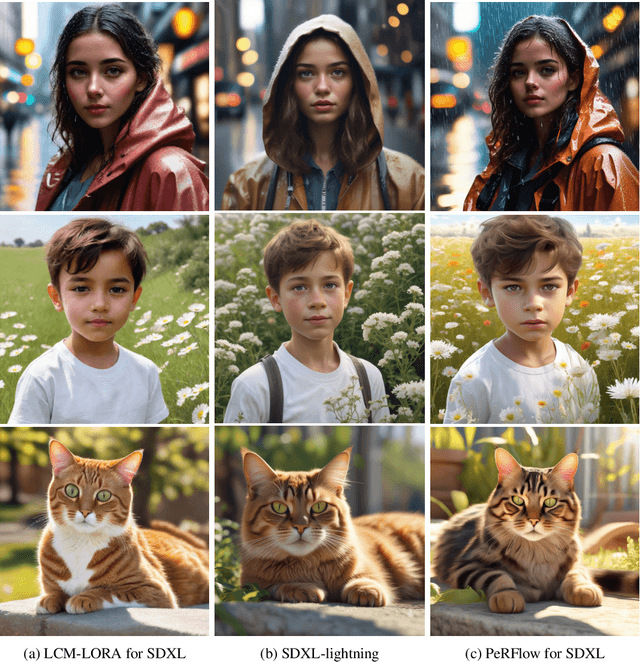
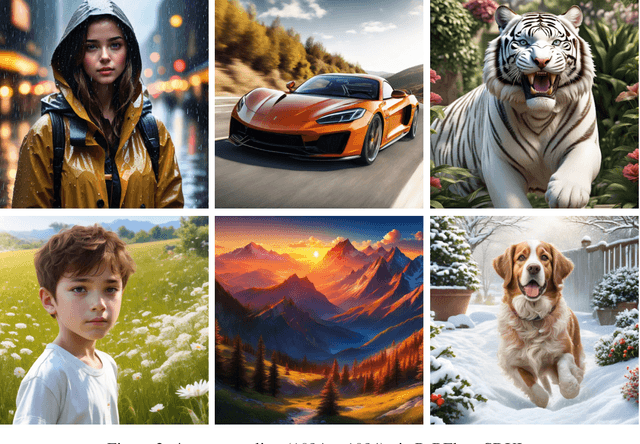
Abstract:We present Piecewise Rectified Flow (PeRFlow), a flow-based method for accelerating diffusion models. PeRFlow divides the sampling process of generative flows into several time windows and straightens the trajectories in each interval via the reflow operation, thereby approaching piecewise linear flows. PeRFlow achieves superior performance in a few-step generation. Moreover, through dedicated parameterizations, the obtained PeRFlow models show advantageous transfer ability, serving as universal plug-and-play accelerators that are compatible with various workflows based on the pre-trained diffusion models. The implementations of training and inference are fully open-sourced. https://github.com/magic-research/piecewise-rectified-flow
MagicVideo-V2: Multi-Stage High-Aesthetic Video Generation
Jan 09, 2024Abstract:The growing demand for high-fidelity video generation from textual descriptions has catalyzed significant research in this field. In this work, we introduce MagicVideo-V2 that integrates the text-to-image model, video motion generator, reference image embedding module and frame interpolation module into an end-to-end video generation pipeline. Benefiting from these architecture designs, MagicVideo-V2 can generate an aesthetically pleasing, high-resolution video with remarkable fidelity and smoothness. It demonstrates superior performance over leading Text-to-Video systems such as Runway, Pika 1.0, Morph, Moon Valley and Stable Video Diffusion model via user evaluation at large scale.
 Add to Chrome
Add to Chrome Add to Firefox
Add to Firefox Add to Edge
Add to Edge